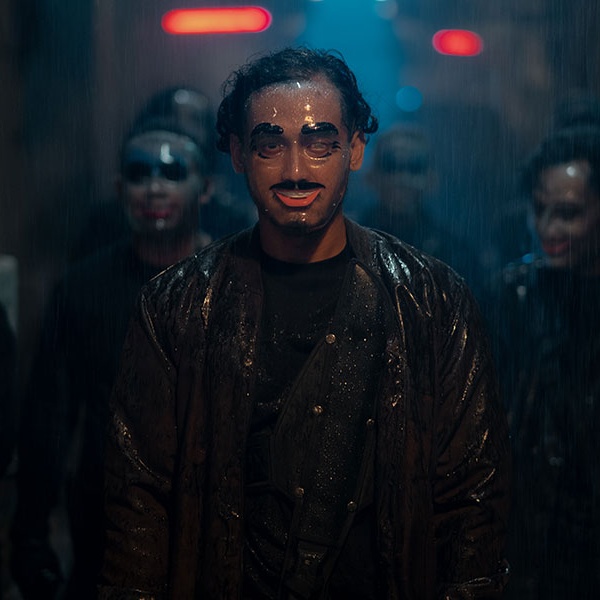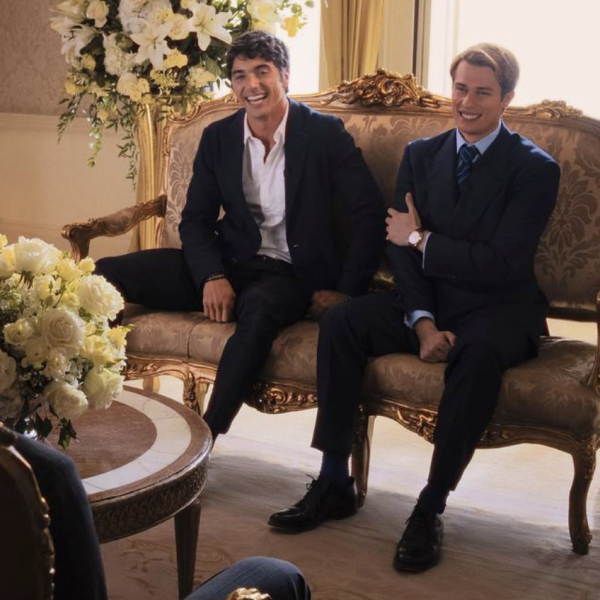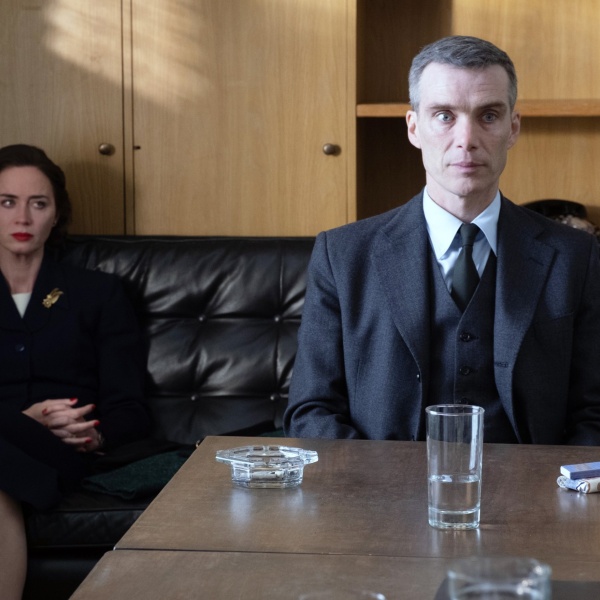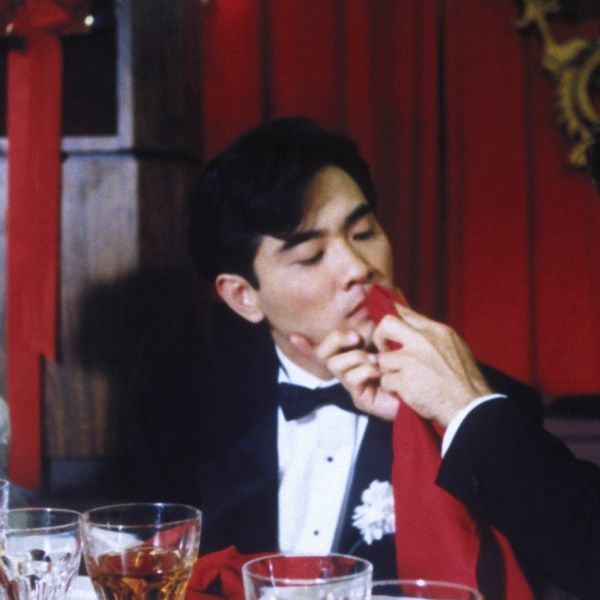
Narrowing down the best movies in any genre is tough, but for lesbian films you have to begin with a reductive question: What is a lesbian film? What, in fact, is a lesbian? (OK, that’s a different piece).
Must the film focus primarily on a gay storyline, or can it feature strong lesbian characters doing something entirely different than just being lesbians? Is subtext enough, or must the sapphic be explicit? How much cinephile wrath will rain down on us for the absence of a certain recent Oscar winner? (Hot dog fingers, we argue, are simply not enough!)
Compared to the stand-outs of queer television, the best lesbian movies have relatively little time to convey their perspective on the vast, varied, (sometimes) vaginal lesbian experience. And yet, ultimately, the best lesbian films honor not just their own perspectives, but also the glory and traditions of all of queer cinema. Strong women, high entertainment value, and bold visuals reign supreme.
The following tales of mini skirt-wearing super-spys and longing period-piece lesbians toe a careful line between caricature and camp. Too often, lesbian characters are turned into stereotypes: either unattractive man-haters or bimbos used for titillation and slasher fodder.
These movies reclaim cinematic lesbianism; they’re the movies you will see played on a loop in the club, or at an underground rooftop movie night. Some won awards; others reached cult status long after their releases. It’s a list as colorful and varied as the queer community itself.
Without further ado, here are the 23 best lesbian films ever made.
With editorial contributions by David Ehrlich, Jamie Righetti, and Tambay Obenson.
23. “D.E.B.S.” (dir. Angela Robinson, 2004)

A clever action parody that was much smarter than its mainstream marketing campaign understood, “D.E.B.S.” is like a queer “Charlie’s Angels” set at the school from “But I’m a Cheerleader,” with broader commercial appeal. A forbidden love story between a teen spy and an evil but hot international diamond thief, the movie features early performances by Jimmi Simpson (“Westworld”) and Jordana Brewster (“The Fast and the Furious”). Set at an underground government academy for teen super spies, the D.E.B.S. are chosen by their answers questions hidden in an SAT-like test. It’s stupidly fun, sweetly romantic, and a lot more subversive than it gets credit for. —JD
22. “The Incredibly True Adventures of 2 Girls in Love” (dir. Maria Maggenti, 1995)

Featuring an interracial romance across class lines, Maria Maggenti’s 1995 classic was years ahead of its time. Inverting the conventions of the day, the story follows an affluent Black teenager named Evie (Nicole Parker) who falls in love with scrappy white tomboy swooningly named Randy Dean (Laurel Holloman). “The L Word” fans may be surprised by Holloman’s kinetic performance as the brooding gas station worker from the wrong side of the tracks, and her smoldering looks keep the chemistry palpably sweet. A charming teen romance laced with incisive commentary on class and race, this queer classic does more than hold up, it ripens with age. —JD
21. “Rafiki” (dir. Wanuri Kahiu, 2018)

Initially banned in its home country of Kenya, this tender queer romance pulses with bright colors and the electric butterflies of young love. The star-crossed romance follows two teens, Kena (Samantha Mugatsia) and Ziki (Sheila Munyiva), who fall in love despite their families’ political rivalry. Stepping lightly into fraught territory, they must contend with small-town busybodies and the judgment of their conservative society. Boasting nuanced performances from the two charismatic newcomers, Wanuri Kahiu’s assured debut feature is an important reminder of the struggle many still face to live out and proud. The first Kenyan film to play Cannes, Kahiu won a landmark court case that earned the film an Oscar-qualifying theatrical run, chipping away at Kenyan anti-LGBT legislation in the process. —JD
20. “Heavenly Creatures” (dir. Peter Jackson, 1994)

For the gift of Melanie Lynskey and Kate Winslet together we must thank Peter Jackson, even if they don’t ride off into the sunset. Based on a true story of a notorious 1950s New Zealand murder case, Jackson understood something only previously known to lesbians: The juicy narrative potential of teen lesbian obsession gone horribly awry. In her debut, Lynskey is delightfully unhinged as Pauline Parker, an outcast who develops an intense friendship with the lovely and wealthy Juliet Hulme, an equally impressive young Kate Winslet. Fantasy — that necessity of queer adolescence that often lingers in adulthood — becomes increasingly real for the two friends, who retreat further into their shared delusions. Like all crazy lesbian relationships, it ends in tragedy. —JD
19. “Pariah” (dir. Dee Rees, 2011)
Every filmmaker gets her crack at a coming-of-age story that mirrors their own, and those stories take on increasing significance when coming from rarely seen perspectives. Humming with the electricity of repressed sexuality finally breaking free, “Pariah” follows teenage Alike (Adepero Oduye) as she embraces her queerness and masculine gender expression. The camera practically aches as Alike changes out of her baseball hat and t-shirt on the train home to Brooklyn, donning a girly sweater in order to calm her parents’ suspicions (Kim Wayans and Charles Parnell). We melt alongside Alike as she lights up with the first tingles of love, seeing herself for the first time through the desiring eyes of Bina (Aasha Davis). Cinematographer Bradford Young (“Arrival”) films Alike’s first nights out at the club in rich, saturated colors. The movie pulses with the rhythm of first love and the cost of self-discovery. —JD
18. “The Favourite” (dir. Yorgos Lanthimos, 2018)

A bold vision set within the grotesquely aristocratic spectacle of early 18th century English royalty, “The Favourite” is a dark yet comedic tale of three dominant women competing for love and power, with reckless abandon. Director Yorgos Lanthimos creates an incredibly lively, though insular, universe, toying with real events to serve as support and motivation for the interiority and conflicts of the film’s characters. Unfolding like a bedroom farce, mostly within the walls of a Royal Palace that’s cut-off from the realities of the era’s expansive history, it’s a world ruled by strategic maneuvers, seductions, even pineapple eating and the occasional duck race. It is through the tangled ties of a frail Queen Anne (Olivia Colman) with two other scheming and ambitious women — her close friend and advisor Lady Sarah (Rachel Weisz), and Sarah’s indigent cousin turned status-seeking chambermaid Abigail (Emma Stone) — that the story plunges into a maelstrom of unscrupulous behavior and unpredictability, that epitomizes the expression “palace intrigue,” as a nation’s fate lies within the relations among women who’ve succumbed to the complications of love. A period tragicomedy with an unexpectedly modern feel, Lanthimos’ take on the British costume drama, is something wonderfully unique. —TO
17. “The Handmaiden” (dir. Park Chan-wook, 2016)

When South Korean auteur Park Chan-wook chose as source material the lesbian historical fiction novel “Fingersmith,” by Welsh author Sarah Waters, it seemed a little out of left field. But changing the setting from Victorian England to Japanese-occupied Korea was a brilliant move, and one that infused this cold mystery about a con man and the two women he embroils in his plot with untold beauty. Chan-wook elevates the book’s tawdry elements to fetishistic extremes, turning out an erotic thriller every bit as gorgeous as it is sinister. Min-hee Kim is prim and alluring as Lady Hideko, never fully dropping the facade even as she falls for her spirited handmaiden, Sook-Hee (Tae-ri Kim), who is tasked with conning her out of her inheritance. As both women make do with the hand life has dealt them, they discover passion in the shared struggle. —JD
16. “Saving Face” (dir. Alice Wu, 2004)

Premiering at the Toronto International Film Festival in 2004, Alice Wu’s buoyantly charming romantic comedy became an instant queer classic, seamlessly balancing cinematic artistry with heartfelt comedy. A satisfying blend of heart-fluttering romance and familial woes, Wu’s film is loosely based on her own experiences coming out to her traditional Chinese family. Featuring a performance from “Twin Peaks” icon Joan Chen, the film follows Wil (Michelle Krusiec), a surgeon who meets and falls for ballet dancer Vivian (Lynn Chen). Accustomed to prioritizing work and family over romantic bliss, she must learn not to let love pass her by. Fourteen years before Lulu Wang’s “The Farewell,” Wu’s film was also populated almost exclusively by Chinese actors (many of whom spoke Mandarin in the film) and was deeply rooted in the immigrant experience. —JD
15. “Set It Off” (dir. F. Gary Gray, 1996)

In the great tradition of “9 to 5” or “Thelma & Louise,” but with three of the most popular black actresses of the time, “Set It Off” remains unrivaled today. Starring Vivica A. Fox, Jada Pinkett Smith, Queen Latifah, and Kimberly Elise as four friends who become bank robbers, each for their own reasons. While lesbians claimed “Thelma & Louise” as their own from subtext alone, “Set It Off” gave audiences the Queen Latifah of their dreams. Cleo was a cocky, loud, swaggering butch. And she gets laid. Finally, a story about badass women fighting the system that kept them down, and no one could say anyone was reading too much into it by calling it queer. “Set It Off” killed at the box office, grossing $41 million on a budget of $9 million. As the success of “Hidden Figures” showed, audiences are clamoring for black female stories. This is one remake no one would question. —JD
14. “Desert Hearts” (dir. Donna Deitch, 1986)

Recently celebrating its 30th anniversary with a gorgeous 35mm screenings at the Museum of Modern Art, this groundbreaking classic was the first time lesbians got to sit in a movie theater, with popcorn, and see a little piece of themselves on the silver screen. Set in the 1950’s and in Reno, Nevada, it follows English professor Vivian Bell (Helen Shaver) as she awaits a divorce and starts a new life. Buttoned up and fragile, Vivian is immediately drawn to firecracker Cay Rivvers (Patricia Charbonneau), a young sculptor who is not afraid to go after what she wants. “Desert Hearts” was the first lesbian movie that didn’t involve a love triangle with a man, or end in tragedy. With sweeping visuals and multiple complex female characters, the staying power of this historic film cannot be denied. —JD
13. “Disobedience” (dir. Sebastián Lelio, 2017)

Sebastián Lelio’s burning-yet-elegant “Disobedience” is more than the familiar feminist rebellion you might think. In the exquisitely melancholic lesbian romance, Rachel Weisz plays Ronit, an excommunicated Jewish woman who unexpectedly returns home after the death of her father. She’s soon reunited with her old friend Dovid, a conflicted Alessandro Nivola, and Esti, David’s wife and Ronit’s secret childhood sweetheart — played by a shapeshifting Rachel McAdams.
The trio’s impromptu exploration of freedom, intimacy, and the conflicts inherent therein offers not just a compelling LGBTQ love story, but a powerful reflection on the rules we choose to follow and those we fight to defy. It also spurs the pièce de résistance of spit kink cinema in a sex scene between Ronit and Esti that’s deeply authentic in its consideration of lesbian connection: a frantic flurry of impassioned embraces and fingers sliding into mouths. The scene was something of A Moment in 2017, and remains a subject of playful debate among sapphic cinephiles. —AF
Read IndieWire’s guide to The Sexiest Queer Movies Ever Made.
12. “The Watermelon Woman” (dir. Cheryl Dunye, 1996)

In 1996, there were only so many images of black women onscreen, not to mention black lesbians. Which is exactly why when Cheryl Dunye cast herself as a documentarian in her feature debut, this clever meta-theatrical device added another layer to what still would have been a charming micro-budget love story. Cheryl is a young, black lesbian living in Philadelphia who becomes obsessed with learning about a black actress from the 1930s, whom she dubs The Watermelon Woman. Based on Dunye’s experience hitting wall after wall while researching black actresses, she invented the character as a fantasy and reclamation. The oh-so-90s-it-hurts aesthetic extends to Cheryl’s plum job as a video store clerk, where she picks up Diana (Guinevere Turner) and takes dating advice from her hilarious butch buddy, Tamara (Valarie Walker). With cameos from Camille Paglia, Toshi Reagon, and Sarah Schulman, this movie has lesbian icons coming out of its… wherever. —JD
11. “High Art” (dir. Lisa Cholodenko, 1998)

The debut effort from “The Kids Are All Right” director traced a less controversial love story (no switching teams here), and still sparkles with that first-feature charm. Syd (Radha Mitchell) is a young art critic assigned to a big profile on notorious photographer Lucy Berliner (Ally Sheedy). Difficult and mysterious, Lucy is Syd’s window into her glamorous world of eccentric bohemian artists. That includes Lucy’s heroin-addicted German girlfriend, Greta (Patricia Clarkson, who steals every scene she’s in). Syd and Lucy find themselves equal to each other, and a dangerous affair begins. Using photography as both flirtation and cinematic device, “High Art” sometimes feels like a contemporary “Carol.” Of course, it was filmed nearly two decades before. —JD
10. “Kissing Jessica Stein” (dir. Charles Herman-Wurmfeld, 2001)

Before she was known as Jon Hamm’s partner, Jennifer Westfeldt was the plucky writer and star of this indie romantic comedy about a neurotic Jew who, like a bisexual Woody Allen, just can’t make up her mind. Westfeldt plays the titular, Jessica, who comes across a pre-Craigslist personal ad so perfectly written it leaves her speechless (a rarity for her). When the person on the other end turns out to be a woman named Helen, played by co-writer Heather Jeurgenson, Jessica embarks on the slowest-moving lesbian affair in history. It’s the kind of New York romance that rarely gets made anymore: There’s charming montages to Ella Fitzgerald’s version of “Manhattan,” a “where did she come from?” hilarious best friend (Jackie Hoffman), and a lovably overbearing Jewish mother (Tovah Feldshuh). Without spoiling the ending (if you haven’t seen it, you really should), there are valid reasons to wish “Kissing Jessica Stein” were a little bit gayer. But the film is a lot like its protagonist; so damn lovely, it’s no wonder everyone wants to kiss it. —JD
9. “Go Fish” (dir. Rose Troche, 1994)

Inspired by the success of Todd Haynes’ “Poison” and frustrated by lesbian films that looked nothing like their actual lesbian lives, Rose Troche and Guinevere Turner decided to take matters into their own hands by shooting a tiny little indie called “Go Fish” in 1994. Filmed in black and white in Chicago for an estimated $15,000, “Go Fish” went on to make roughly $2.4 million, proving indies could make a profit. Turner played Max, a headstrong writer who begins dating the older, quieter Ely (V.S. Brodie), despite initial reservations. Max’s friends, a jovial lesbian peanut gallery, offer unsolicited advice and plenty of laughs. No one dies, and no one comes out; a novelty for gay films at the time. “Go Fish” not only changed the game for queer cinema, but for indie film of all kinds. —JD
8. “Portrait of a Lady on Fire” (dir. Céline Sciamma, 2019)

Celine Sciamma’s luscious tour-de-force practically demands to be seen on the big screen, but its subtle glances and rich performances offer plenty to unpack on repeat viewings. There are only four characters in the film, all women: A painter, her elusive subject, her mother, and their maid. The setting is a damp and nearly empty manor house on an island in Brittany, the part of France that bears the closest resemblance to England.
A British austerity permeates the film’s first act, all cold shoulders and sidelong glances between the women, but Sciamma delivers the French passion by the film’s fiery conclusion — and then some. While the romance is undoubtedly the heart of “Portrait,” Sciamma also seamlessly infuses the film with evidence of women’s limited options, or rather, the endlessly creative ways they learned to skirt the rules. Shut out by a home country that stubbornly refuses to honor its great women filmmakers, the film itself stands ablaze in defiance of — and in glaring contradiction to — the dominance of men. Burn it down. —JD
7. “Born In Flames” (dir. Lizzie Borden, 1983)

Set in a post-revolutionary America, Lizzie Borden’s feminist agitprop film remains as bracingly radical as the day it was made. Shot guerilla style in 1980s New York City, the film is an inventive mash-up of energizing original musical numbers, free-wheeling handheld action shots, and news footage of actual demonstrations and police violence. The story is told through two underground feminist radio hosts who mobilize their factions after the Black radical founder of the Woman’s Army is suspiciously killed in police custody. Though this wildly inventive film defies categorization, it is best described as an afro-futurist political sci-fi comedy — the only one of its kind. Featuring performances from a young Kathryn Bigelow, Eric Bogosian, and civil rights activist Florynce Kennedy, “Born in Flames” is a vital affirmation of lesbian political power. —JD
6. “All Over Me” (dir. Alex Sichel, 1997)

Angst-ridden teenagers come in all shapes and predilections, a fact this prettily gritty coming-of-age film celebrates. Two years after Larry Clark’s controversial “Kids” came out, “All Over Me” properly queered up New York’s counterculture as seen through the eyes of Claude (Allison Folland), a gentle loner who follows her wild best friend, Ellen (Tara Subkoff), around like a sad puppy. She has a chance at breaking free when she meets pink-haired cutie Lucy (Leisha Hailey), but gets pulled back in when Ellen’s boyfriend drama becomes dire. By Hollywood standards, Claude’s extra baby fat made her an unconventional lead, which only adds to the film’s rebellious charm. Like “Desperately Seeking Susan” with kissing, or “Kids” without homophobia, “All Over Me” borrowed from the greats, and remains wholly original. —JD
5. “Tomboy” (dir. Céline Sciamma, 2007)

The great AIDS activist and playwright Larry Kramer often says gay people are smarter than other people. If that entirely subjective and thoroughly provocative statement has any merit, the reason would be childhood. Gay people become self-reflective early; you become acutely aware of the world around you by observing your place outside of it. There is not a single film that captures a more universal queer childhood experience than Céline Sciamma’s “Tomboy,” a quietly gorgeous portrait of a 10-year-old named Laure who moves to a new town and introduces herself as Mikael. It’s the kind of movie that’ll have you waiting on your ex’s doorstep just to talk about it. (True story, but not my own). “Tomboy” strikes the perfect balance between lighthearted and heartbreaking, between the joy of a fantasy realized and the harsh sting of reality. Though the film came out in 2011, it feels utterly timeless; the golden days of Laure’s summer could — and do — belong to anyone who recognizes themselves. —JD
4. “Carol” (dir. Todd Haynes, 2015)

Whenever Todd Haynes’ unspeakably beautiful Patricia Highsmith adaptation comes to mind, it brings some of the novel’s last words along with it: “It would be Carol, in a thousand cities, a thousand houses, in foreign lands where they would go together, in heaven and hell.” In that light, a spot on a list of the decade’s best films hardly seems like much of a reach.
Brought to life by the careful genius of Phyllis Nagy’s script, the supple glow of Ed Lachmann’s 16mm cinematography, and two of the most extraordinary performances ever committed to celluloid (which isn’t to sweep old Harge under the rug where he belongs), Haynes’ Carol is more than just a bone-deep melodrama about a mutual infatuation during a repressive time. It’s more than a vessel for Carter Burwell’s swooning career-best score, or Sandy Powell’s seductive costumes, or the rare queer romance that gave its characters a happy ending — an ending that resonates through Cate Blanchett’s coy smile with the blunt force of every impossible dream Carol Aird has ever had for herself. It’s more than just an immaculate response to decades of “if only” dramas like David Lean’s “Brief Encounter,” or a heartstopping series of small gestures that build into the single most cathartic last shot of the 21st century. It’s all of those things (and more!), but most of all it’s an indivisibly pure distillation of what it feels like to fall in love alone and land somewhere together. —DE
3. “Bound” (dir. The Wachowskis, 1996)

Before The Wachowskis became a worldwide sensation with “The Matrix,” and long before either came out as transgender, the directing duo showed early signs of queerness with “Bound.” A noir thriller starring Gina Gershon and Jennifer Tilly as ex-con Corky and femme fatale Violet, “Bound” gave the world the most sumptuous partners in crime that queer cinema has ever seen. Fresh out of the joint and set up with a gig as a handyman, Corky catches Violet’s eye while plugging a leak in her boyfriend’s apartment, a crooked mobster by the name of Caesar (the always excellent Joe Pantoliano). Violet soon learns Corky is great with all kinds of plumbing, and they begin a secret love affair. Desperate to run off together, they hatch a plan to steal millions from Caesar’s bosses and pin the blame on him.
Tilly uses her signature husky voice to hide her cleverness behind a ditzy persona, and Gershon proves her acting mettle by rocking that motorcycle jacket as well as any true leather dyke. Wearing its noir influences proudly on its sleeve, “Bound” is not only a classic lesbian film, but it’s also the only Wachowski-directed project firmly outside the sci-fi genre. That makes it a rare window into this iconic directing duo, and one that LGBT viewers have proudly embraced into the fold. —JD
2. “Mulholland Drive” (dir. David Lynch, 2001)

In love all great things must come to an end, but with David Lynch those ends are usually a lot darker and bloodier than usual. The plot of “Mulholland Drive” has been puzzled over since its release in 2001, with vignettes that recall “Pulp Fiction” interweaving with mysteries about identity and love, and blanketed by purposefully shaky timelines. While the steamy sex between Naomi Watts and Laura Harring might seem sudden, it is grounded in part by one of cinema’s most puzzling and gorgeous scenes, as Rebekah Del Rio sings until she literally drops, bringing both women to tears. “Mulholland Drive” might expose the seedy underbelly of Hollywood, but it also shows the escapism that love can provide, and the lengths we will go to keep that stability alive. —JR
1. “But I’m a Cheerleader” (dir. Jamie Babbit, 1999)

For the concept, the chemistry, and the camp, Jamie Babbit’s “But I’m a Cheerleader” takes the cake. Unapologetically queer in all senses of the word, (this is the kind of movie for which terms like “offbeat” and “quirky” were invented), this film makes low budget look cool. When it came out in 1999, it was the final gasp of the New Queer Cinema, a bridge between the indies that brought the first wave of gay stories to the screen and the post-Ellen era that paved the way for more commercial fare like “The L Word.” At its heart was a love story as sweet and sexy as an audience might hope for.
Set in the present day with a bold retro aesthetic, the movie stars a young Natasha Lyonne as Megan, an innocent cheerleader sent to a rehab for gay and lesbian teens. The patients wear pink and blue uniforms while learning about gender roles and preparing for straight-sex simulations. Of course, putting a bunch of gay kids in a house together is bound to create some sexual tension, and Megan‘s gay little heart stands no chance against the dark and brooding Graham (Clea Duvall). Babbit delivers the best of both worlds with a genuine and touching romance that blossoms amidst the wildly entertaining satire. Featuring an all-star cast that includes RuPaul, Melanie Lynskey, Michelle Williams, Cathy Moriarty (“Patti Cake$”), Eddie Cibrian, and brief appearances by Julie Delpy and Ione Skye, “But I’m a Cheerleader” has everything. —JD








